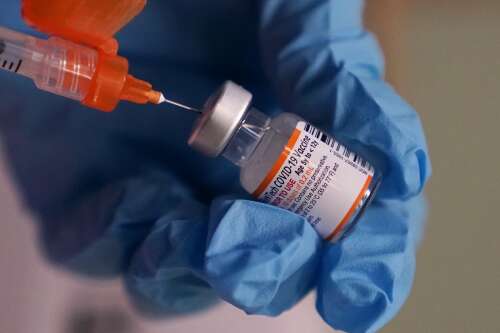COVID figures are rising once again in Illinois, but public health officials note they are not translating into a significant spike in hospitalizations.
AP photo/2021
Illinois is experiencing an uptick in COVID infections, but it’s not as significant as some other states are experiencing and it’s also not translating into an increase in hospitalizations.
But public health officials warn the annual “summer surge” is in its infancy.
“We have seen similar waves of increased activity in previous seasons during the summer in both percent positivity and (emergency room) visits,” said Mike Claffey, an Illinois Department of Public Health spokesman. “We haven’t seen a significant increase in ER visits or hospitalizations, so it’s likely that this is pointing to a milder variant from a clinical standpoint, based on current trends.”
IDPH figures show 8.5% of reported COVID tests for the week ending July 6 were positive. That’s up from 2.8% at the start of June.
The U.S. Centers for Disease Control and Prevention is reporting more than 10% of COVID tests taken in the six-state region that includes Illinois last week were positive.
However, public health officials note tracking largely is voluntary and fewer tests are taken in the summer months, leading to potentially inflated counts.
“We often see test positivity rise when fewer people are being tested because the people being tested tend to have more symptoms,” said Dr. LaMar Hasbouck, Cook County Department of Public Health chief operating officer. “Hospital admissions remain low overall but have been trending up over the last six weeks. We are currently seeing levels similar to those seen at the start of the summer wave in 2023.”
Nationally, the southern and southwestern states are seeing a higher number of cases and hospitalizations in recent weeks, according to CDC records. That has commonly happened since the start of the pandemic as hot weather forces more people inside. It’s the same reason, experts say, that cold weather states like Illinois see larger infection peaks in the winter when frigid temperatures move social gatherings indoors.
Earlier this week, Dr. Andrea Garcia, vice president of science, medicine and public health at the American Medical Association, gave an update about COVID figures nationally.
“Nationally, coronavirus activity in wastewater remains low but it is increasing,” she reported in the online AMA interview. “Experts do say that wastewater is best interpreted as a way of understanding which way the virus is trending. In this case, all indicators are pointing to up at this point.”
Deaths, which are a lagging indicator, remain low both nationally and in Illinois. For the week ending July 6, only four deaths were attributed to COVID, according to IDPH figures.
IDPH is reporting 807 COVID deaths this year, so far.
Claffey said the current dominant strain of COVID is among the same family that current vaccines were manufactured to thwart. Additionally, he noted that “antivirals are still effective against these variants and so those at risk for serious illness should access treatments as soon as they become symptomatic.”
Public health experts reiterated that older populations and those with underlying health conditions remain most at risk from severe outcomes from COVID infections.
“The (hospitalization) rate for individuals 65 years and older is 10 times higher than all other ages groups,” Hasbrouck said.
